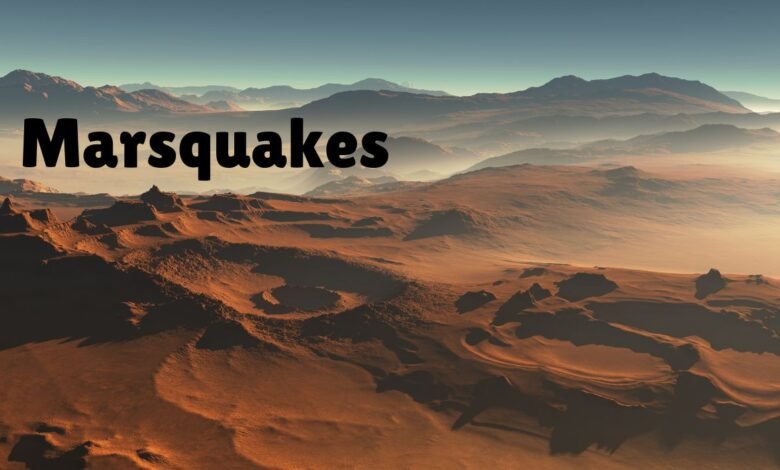Can meteorite strikes cause quakes on Mars?
Mars tremors? Learn if meteorite impacts trigger earthquakes on the Red Planet

Discover if meteorite strikes can cause quakes on Mars. Uncover the connection between impacts and seismic activity on the Red Planet.
When we think of quakes, it’s usually Earth that comes to mind. However, Mars also experiences seismic activity, known as ‘Marsquakes.’ These quakes, much like their terrestrial counterparts, are caused by the release of energy within the planet’s crust. Understanding Marsquakes is crucial for scientists as it provides valuable insights into the Martian interior structure. By studying the frequency, magnitude, and location of these quakes, researchers can infer details about the composition and behavior of the planet’s mantle and core.
The significance of studying Marsquakes extends beyond mere curiosity. Knowledge of the internal structure of Mars helps scientists compare and contrast it with Earth, offering a broader understanding of planetary formation and evolution within our solar system. Furthermore, this information is vital for future missions and potential human settlement, as it can inform construction strategies to mitigate the impact of seismic activity.
One intriguing hypothesis is that meteorite strikes may be a significant source of Marsquakes. Unlike Earth, Mars lacks a thick atmosphere that can burn up incoming meteoroids, making it more susceptible to frequent and direct meteorite impacts. These impacts can generate substantial force, causing tremors that propagate through the Martian crust. Investigating the correlation between meteorite strikes and Marsquakes can help us understand the dynamics of seismic activity on Mars more comprehensively.
This blog post will delve deeper into the relationship between meteorite strikes and Marsquakes, exploring the evidence, scientific observations, and implications of this fascinating phenomenon. By examining this connection, we aim to shed light on how external forces like meteorite impacts can influence the geophysical processes of our neighboring planet.
What Causes Quakes on Mars?
Marsquakes, the Martian equivalent of earthquakes, occur due to several factors, diverging notably from the tectonic-driven quakes on Earth. On Mars, the absence of active plate tectonics necessitates a closer examination of alternative contributors to seismic activity. One primary cause is tectonic activity, albeit different in nature from Earth’s. Mars exhibits significant fault lines and volcanic regions, which can induce quakes as the planet’s crust adjusts to stresses.
Another critical factor is thermal contraction. As Mars cools, the planet’s surface contracts, leading to fractures and subsequent seismic events. This process is accentuated by the significant temperature variations between Martian day and night, as well as seasonal changes. The resulting stress on the crust can trigger quakes, especially in regions with pre-existing weaknesses.
Meteorite impacts also play a significant role in causing quakes on Mars. Unlike Earth, where the atmosphere shields the surface from smaller meteorites, Mars’s thin atmosphere allows more frequent surface impacts. When a meteorite strikes, it releases a considerable amount of energy, causing shockwaves that propagate through the Martian crust, leading to seismic activity. These impacts can vary in magnitude, with larger meteorites inducing more substantial quakes.
Given the unique geological dynamics of Mars, the combination of tectonic adjustments, thermal contraction, and meteorite impacts collectively contribute to the seismic landscape of the Red Planet. Understanding these factors is essential for comprehending the complex nature of Marsquakes, with meteorite strikes emerging as a particularly noteworthy contributor. As research progresses, continued analysis will elucidate the intricate interplay of these causes, offering deeper insights into Martian seismicity.
Meteorite Impacts on Mars
Meteorites are fragments of rock or metal that originate from space and survive their passage through the atmosphere to reach a planetary surface. These celestial objects, often remnants of comets or asteroids, can vary significantly in size, from tiny grains to massive boulders. When meteorites impact a planet’s surface, they can create craters and release substantial amounts of energy.
On Mars, meteorite impacts occur with relatively high frequency compared to Earth. This is primarily due to Mars’ thinner atmosphere, which offers less resistance to incoming meteorites. Consequently, more meteorites reach the Martian surface without burning up. While Earth’s thick atmosphere causes many smaller meteorites to disintegrate before impact, Mars’ atmosphere allows a greater number of these space rocks to make contact with the ground.
The size of meteorite impacts on Mars can range from small, barely noticeable dents to large craters several kilometers in diameter. When a meteorite strikes Mars, it travels at high velocities, often exceeding tens of kilometers per second. Upon impact, the kinetic energy of the meteorite is converted into heat and shock waves, resulting in the excavation of a crater and the ejection of material from the impact site. This release of energy can be immense, with larger meteorites capable of generating forces equivalent to multiple nuclear explosions.
Moreover, the frequency of meteorite impacts on Mars is influenced by the planet’s location within the solar system and its lack of geological activity compared to Earth. Mars experiences fewer tectonic movements and volcanic eruptions, which means that the surface features created by meteorite impacts are more likely to be preserved over long periods. This allows scientists to study these impacts in greater detail, providing valuable insights into the history of the Martian surface.
Understanding meteorite impacts on Mars not only helps us comprehend the planet’s geological history but also informs our knowledge of potential hazards for future human exploration and settlement. By studying these impacts, researchers can better predict and mitigate the risks posed by meteorites to both robotic and manned missions on Mars.
How Meteorite Impacts Cause Quakes
The phenomenon of meteorite impacts causing quakes, also known as seismic activity, on Mars is a fascinating subject that combines the principles of planetary science and seismology. When a meteorite strikes the Martian surface, it generates an immense amount of energy. This energy is released in the form of shock waves, which propagate through the crust of Mars, causing it to tremble.
Upon impact, several processes occur almost simultaneously:
- Energy Release: The kinetic energy of the incoming meteorite is converted into seismic energy.
- Shock Wave Generation: The sudden release of energy generates shock waves that spread outwards from the point of impact.
- Crustal Deformation: The shock waves cause the Martian crust to deform, leading to fractures and seismic activity.
- Propagation of Seismic Waves: These waves travel through the crust, diminishing in intensity as they move further from the impact site.
Shock waves are classified into two main types: primary (P-waves) and secondary (S-waves). P-waves are compressional waves that travel faster and are the first to be detected. S-waves, on the other hand, are shear waves that travel slower but cause more significant ground movement. The interaction between these waves and the Martian crust results in the seismic activity that we observe as quakes.
Additionally, the characteristics of the Martian crust play a crucial role in how these seismic waves propagate. Factors such as crustal composition, density, and existing fault lines can influence the intensity and reach of the quakes. Understanding these dynamics is essential for interpreting seismic data collected by landers and rovers on Mars, and for gaining insights into the planet’s geological history and structure.
In summary, meteorite impacts on Mars are a key driver of seismic activity, providing valuable data that helps scientists better understand the Red Planet’s internal structure and geological processes.
Evidence from Martian Missions
NASA’s InSight lander has been instrumental in monitoring seismic activity on Mars, providing critical data to understand the planet’s geology. Since its deployment, InSight has identified numerous seismic events, many of which are believed to be directly related to meteorite impacts. This connection between meteorite strikes and Marsquakes is pivotal in expanding our knowledge of Martian seismicity and the planet’s internal structure.
One notable instance is the detection of a series of seismic waves linked to a meteorite impact in late 2020. InSight’s seismometer, known as SEIS (Seismic Experiment for Interior Structure), recorded distinct tremors that were later traced back to an impact event. Through precise measurements of the seismic waves’ arrival times and their propagation paths, scientists were able to pinpoint the impact location and confirm its role in generating the Marsquake.
Additionally, the mission has observed several other similar events, where the characteristics of the seismic data—such as wave frequency and amplitude—correspond with the expected signatures of meteorite impacts. These observations have been corroborated by orbiters equipped with high-resolution cameras, which have identified fresh impact craters in proximity to the detected seismic events. Such multi-instrument confirmation strengthens the hypothesis that meteorite impacts are significant contributors to Marsquakes.
InSight’s ability to detect these impacts is largely due to the sophisticated design of its instruments. SEIS is sensitive enough to capture even the faintest tremors, allowing for detailed analysis of seismic waves. The data collected not only helps in understanding the immediate effects of meteorite impacts but also sheds light on the Martian crust’s properties and the planet’s internal dynamics.
Overall, the evidence gathered from InSight and other Martian missions underscores the importance of continuous seismic monitoring. By linking meteorite impacts to observed Marsquakes, scientists can gain deeper insights into Mars’ geological activity, contributing to our broader understanding of planetary science.
Comparing Marsquakes to Earthquakes
The phenomenon of seismic activity on Mars, commonly referred to as Marsquakes, presents both intriguing similarities and notable differences when compared to earthquakes on Earth. One of the primary distinctions lies in the magnitude and frequency of these seismic events. Earthquakes typically exhibit a broad range of magnitudes, with some reaching devastating levels of intensity. In contrast, Marsquakes tend to be less powerful, with most recorded events falling below the magnitude that would cause significant surface damage. This discrepancy is largely due to the differences in the internal structures and tectonic activities of the two planets.
Another critical difference is the frequency of seismic events. On Earth, the movement of tectonic plates is a continuous and dynamic process, leading to frequent earthquakes. Mars, however, lacks the same level of tectonic activity. Its seismic events are less frequent and are often caused by different mechanisms, such as the cooling and contraction of the planet’s crust or the impact of meteorites. The absence of active plate tectonics on Mars means that its quakes are generally less frequent and are often linked to volcanic activity or the aforementioned impacts.
Studying Marsquakes offers valuable insights into the geological history and internal structure of Mars, which in turn enhances our understanding of Earth’s seismic activity. By comparing the seismic data from both planets, scientists can develop more comprehensive models of planetary evolution and geophysical processes. For instance, the analysis of seismic waves on Mars can reveal information about its crust, mantle, and core, providing clues about the planet’s formation and thermal history. These insights can also help scientists understand the potential for seismic activity on other celestial bodies.
Simple comparisons, such as the differences in magnitude and frequency, help to underscore the unique characteristics of Marsquakes. While Earthquakes are primarily driven by the dynamic movement of tectonic plates, Marsquakes offer a glimpse into a planet with a more static and cooling interior. This comparative study not only enriches our knowledge of Mars but also provides a broader context for interpreting seismic phenomena across the solar system.
Implications for Mars Exploration
The phenomenon of meteorite-induced Marsquakes carries profound implications for the future of Mars exploration. Understanding these quakes is crucial for designing safer habitats for future human missions. By studying the seismic activity resulting from meteorite impacts, scientists can gain valuable insights into the structural integrity of the Martian crust. This knowledge enables the construction of habitats that can withstand seismic shocks, ensuring the safety of astronauts during prolonged stays on the Red Planet.
Furthermore, recognizing the patterns and frequencies of Marsquakes can significantly assist in the selection of landing sites for future missions. Areas with lower seismic activity might be preferred for setting up long-term bases or conducting delicate scientific experiments. Conversely, regions with frequent Marsquakes could be targeted for geological studies, offering a unique opportunity to investigate the subsurface structure and composition of Mars. By correlating seismic data with geological features, researchers can map the planet’s interior and better understand its geological history.
In addition, understanding meteorite-induced Marsquakes can help in the development of more accurate models for predicting seismic activity on Mars. These models are essential for mission planning and risk assessment. They can inform the design of structures, equipment, and protocols to mitigate the risks associated with seismic events. This proactive approach not only enhances the safety of human explorers but also ensures the longevity and functionality of robotic missions.
Overall, the study of meteorite-induced Marsquakes offers a wealth of information that is indispensable for the advancement of Mars exploration. By leveraging this knowledge, space agencies can make informed decisions that bolster the success and sustainability of future missions, paving the way for humanity’s next giant leap.
- Chang’e-5 mission finds graphene on Moon, shaking up theories about our lunar neighbor’s formation!
- Doughnut-Shaped Solar System? Scientists Rethink Early Solar System Formation
- NASA Has Given a 1 Billion Dollar Deal to SpaceX: SpaceX to Deorbit the ISS Despite Options
Conclusion
The investigation into whether meteorite strikes can cause quakes on Mars has yielded significant insights. Throughout this blog post, we have examined the geological processes of Mars, the characteristics of meteorite impacts, and the observations made by missions such as InSight. Evidence suggests that meteorite-induced Marsquakes are indeed plausible, as impacts can generate seismic waves capable of traversing the Martian surface.
Understanding meteorite-induced Marsquakes is crucial for several reasons. Firstly, it provides a window into the internal structure of Mars, revealing vital information about its crust, mantle, and core. Secondly, by studying these phenomena, scientists can better predict and mitigate potential hazards for future human missions. Lastly, this knowledge enhances our broader comprehension of planetary science and comparative geology across the solar system.
Ongoing and future research efforts are pivotal in deepening our understanding of these seismic events. Current missions continue to collect data, while planned missions aim to deploy more advanced seismometers and other instruments to detect and analyze Marsquakes with greater precision. Collaboration between international space agencies and research institutions will play a key role in advancing this field.
As we look to the future, the importance of continued exploration and study of Mars cannot be overstated. New discoveries await that could transform our understanding of the Red Planet and its history. We encourage readers to stay informed about Mars exploration, as each new finding brings us one step closer to unveiling the mysteries of our neighboring planet.



